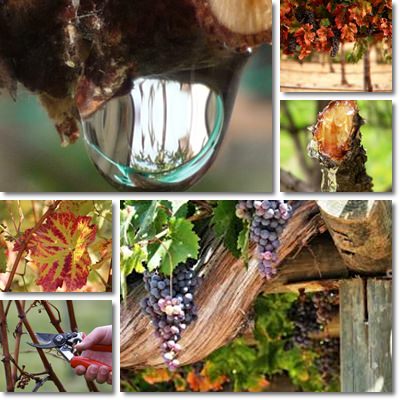Every spring after pruning, grapevine sap of clear color oozes from the cut stems, making it look as if the vines are crying, mourning, hence the very poetic name: tears of grapevine or bleeding grapevine. This phenomenon was believed to possess magical implications as people would use the grape sap to cure a variety of medical conditions, ranging from skin problems, rashes, indigestion and even snakebites. Even nowadays, there is a strong belief, especially among older people, that grapevine sap possesses incredible curative properties.
Grapevine sap has come to the attention of modern medicine after it became known that it could cure eyesores, acne, bowel upsets and prevent open wounds from getting infected. Recent research into the properties and health benefits of grapevine sap has come to some surprising results: it appears that grapevine sap, the clear, watery liquid dripping from freshly pruned grape vines has amazing antimicrobial, anti-inflammatory and astringent properties. Even more, grapevine sap contains viniferine, a potent natural substance which can restore radiance to one’s skin.

How is grapevine sap collected and stored?
After grapevines have been cut to stimulate growth and fruit production, they will start secreting a clear, watery liquid of little to no flavor for up to several weeks, depending on the age and thickness of the vine. This liquid is called grapevine sap. In order to collect it, small glass bottles are gently and loosely tied to the oozing vine, with the bottle neck right underneath the cut in the vine oozing sap. A small bottle can fill up in hours or days, depending on how much sap is dripping from the grapevine and should be stored in closed glass containers like small bottles, away from light and at room temperature to preserve the sap fresh longest. Find out below what are the traditional uses of grapevine sap.
Grapevine sap uses and benefits
Grapevine sap is a potent anti-inflammatory as well as antiseptic agent.
Traditionally, grapevine sap was used to treat conjunctivitis, blepharitis (swelling of the eyelids) as well as any form of internal or external styes. For the treatment of conjunctivitis and internal styes, the sap was dripped into the eyes every morning and evening until the eyes returned to their normal state of health. Blepharitis and external styes were cured by washing the eyes with freshly collected grapevine sap (see article on eye styes: causes, symptoms and treatment).
Additionally, sap was dripped into the eyes as well so as to prevent the spread of the infection. Although scientific evidence supports the claim that grapevine sap is a potent anti-inflammatory and antiseptic agent, when dealing with delicate medical conditions such as eye problems, it is always wise to ask for your doctor’s advice first.

The antiseptic and astringent properties of grapevine sap can help treat rashes and acne.
Grapevine sap is said to reduce the itching caused by rashes or eczema and combat acne due to its powerful antiseptic and astringent properties. Similarly, regular use is said to help treat blemishes.
Grapevine sap helps detoxify the liver and has powerful diuretic properties
Traditionally, people suffering from liver or kidney problems would drink a cup of fresh grapevine sap every morning before breakfast in order to purify the blood, detoxify the liver and improve kidney function. The sap contains minerals, sugars and phytochemicals meant to protect the vine from frost damage and help buds develop in spring. This sort of purified water, full of nutrients, was believed to have positive effects on human health and promote blood and liver detoxification.
Grapevine sap contains viniferine, a potent natural antioxidant.
Viniferine is the key-ingredient in many quality skin care products aiming at reducing redness, blemishes and boosting skin radiance. According to a study conducted by Professor Vercauteren at the Montpellier Faculty of Pharmacy, viniferine is actually ’62 times more powerful than vitamin C’ when it comes to restoring skin beauty.
Below is a video filmed April 8, 2018, in which you can see a tiny drop of sap dripping from the grapevine. The liquid looks clear like fresh spring water and can be collected by attaching a small glass bottle to the grapevine for several days. Not all vines will produce the same amount of sap, so it’s ideal to collect it from several different places to make sure you get a decent amount.
What is interesting is that in the past women would wash their face every spring with fresh grapevine sap. My grandmother herself claims that the sap kept her skin free of age spots, dark circles under the eyes and blemishes and made her look fresh and radiant. But how does viniferine work? Viniferine improves circulation and harmonizes melanin production, thus ensuring no dark spots appear and the skin preserves a healthy glow.
Conclusion
Grapevine sap is a natural substance, a sort of purified water rich in nutrients, particularly minerals. It can be said that its use can cause no harm, especially if it is external. However, my advice is to always ask for a doctor’s advice if you are planning on resorting to any form of alternative medicine, especially if you are already dealing with a medical problem. Aside from this, it is said to do wonders for the skin in particular and I admit that, if I could get my hands on some fresh sap, I would be extremely eager to wash my face with it and see myself putting on a beautiful, healthy glow.
